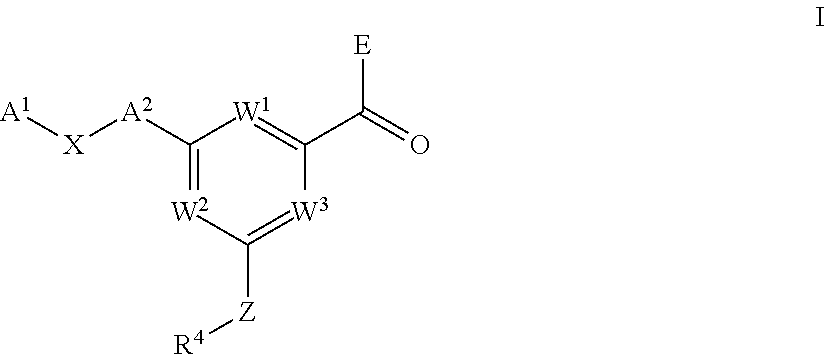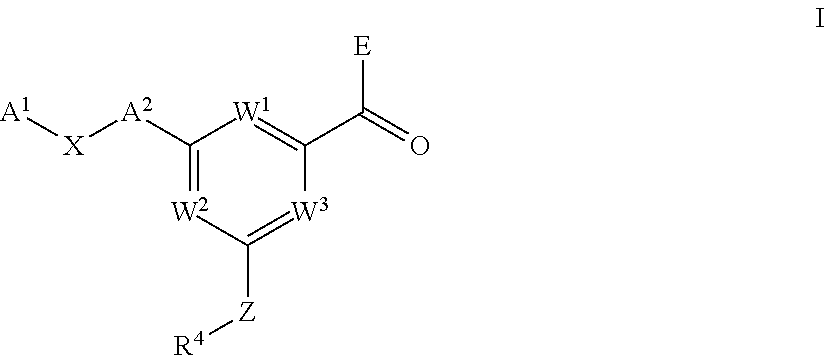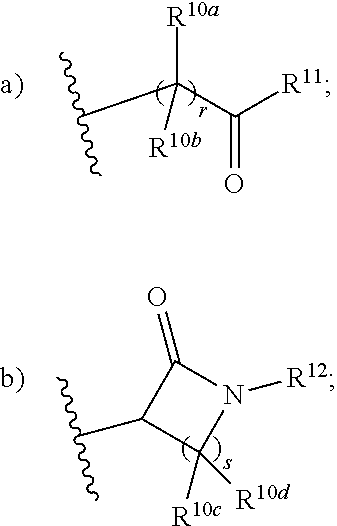Pyrimidines as sodium channel blockers
a sodium channel blocker and pyrimidine technology, applied in the field of substituted pyrimidine compounds, can solve the problems of many undesirable side effects of the currently available treatments
- Summary
- Abstract
- Description
- Claims
- Application Information
AI Technical Summary
Benefits of technology
Problems solved by technology
Method used
Image
Examples
example 1
Preparation of 2-fluoro-6-(4-(4,4,5,5-tetramethyl-1,3,2-dioxaborolan-2-yl)phenoxy)pyridine
[0695]
[0696]A sealed pressure glass vessel containing the mixture of 2,6-difluoropyridine (2.1 g, 18 mmol, Aldrich), 4-(4,4,5,5-tetramethyl-1,3,2-dixoaborolan-2-yl)phenol (4 g, 18 mmol), and Cs2CO3 (7 g, 21 mmol, Aldrich) in DMF (25 mL) was heated at 80° C. for 4 h. After cooling to room temperature, the mixture was diluted with brine (200 mL) and extracted with EtOAc (2×200 mL). The combined organic layers were dried over Na2SO4, filtered, and concentrated on a rotary evaporator. The residue was purified via silica gel chromatography (0-10% EtOAc in hexane) to give 2-fluoro-6-(4-(4,4,5,5-tetramethyl-1,3,2-dioxaborolan-2-yl)phenoxy)pyridine as viscous liquid (3.6 g, 63%). 1H NMR (400 MHz, CDCl3): 7.87 (2H, d, J=8.8 Hz), 7.76 (1H, q, J=7.6 Hz), 7.15 (2H, d, J=8.8 Hz), 6.73 (1H, dd, J=1.6, 8 Hz), 6.63 (1H, dd, J=2.8, 8 Hz), 1.37 (12H, s). LC / MS: m / z=316 [M+H]+. Unless otherwise indicated all 1H N...
example 2
Preparation of (S)-6-((1-amino-1-oxopropan-2-yl)amino)-2-(4-(4-fluorophenoxy)phenyl)pyrimidine-4-carboxamide (Cpd No. 1)
[0710]
2,6-dichloropyrimidine-4-carbonyl chloride
[0711]A mixture of orotic acid mono hydrate (34.828 g, 200.0 mmol), phosphorus oxychloride (100 mL, 1092 mmol) and 20 drops of DMF were heated at 110° C. overnight. After cooling, the dark mixture was diluted with 500 mL hexanes and vigorously stirred. The hexane layer was decanted and quickly washed with water (1×100 mL) then brine (1×100 mL) and dried over MgSO4. The organics were filtered and carefully evaporated in vacuo to give 2,6-dichloropyrimidine-4-carbonyl chloride as a light yellow liquid (26.13 g, 123.6 mmol, 62% yield). 1H NMR (400 MHz, CDCl3): 7.93 (1H, s).
[0712]
2,6-dichloropyrimidine-4-carboxamide
[0713]To a solution of 2,6-dichloropyrimidine-4-carbonyl chloride (26.13 g, 123.6 mmol) in Et2O (500 mL) was added a mixture of 0.5M ammonia in dioxane (250 mL, 125 mmol) and iPr2NEt (22 mL, 126 mmol) dropwise ...
example 3
Preparation of 6-(2-carbamoylpiperazin-1-yl)-2-(4-(4-fluorophenoxy)phenyl)pyrimidine-4-carboxamide (Cpd No. 27)
[0720]
[0721]As To a milky suspension of the tert-butyl 3-carbamoyl-4-(6-carbamoyl-2-(4-(4-fluorophenoxy)phenyl)pyrimidin-4-yl)piperazine-1-carboxylate (0.363 g, 0.677 mmol) in dioxane (10 mL) was added 4M HCl in dioxane (2 mL, 8 mmol). After stirring for 3 days the reaction was concentrated in vacuo. The solid residue was partitioned between 10 mL EtOAc and 2 mL 2M aqueous Na2CO3 solution. The mixture was diluted with 25 mL EtOAc, 8 mL water and 25 mL brine. The organic layer was separated and the aqueous layer was extracted four times with 25 mL EtOAc. The combined organic layers were dried over MgSO4, filtered, and evaporated in vacuo. The residue was triturated with 2 mL 1:1 EtOAc / hexanes, filtered, and rinsed once with 2 mL 1:1 EtOAc / hexanes. The solid was dried under vacuum at 40° C. to give the product 6-(2-carbamoylpiperazin-1-yl)-2-(4-(4-fluorophenoxy)phenyl)pyrimid...
PUM
| Property | Measurement | Unit |
|---|---|---|
| temperatures | aaaaa | aaaaa |
| pH | aaaaa | aaaaa |
| pH | aaaaa | aaaaa |
Abstract
Description
Claims
Application Information
 Login to View More
Login to View More - R&D
- Intellectual Property
- Life Sciences
- Materials
- Tech Scout
- Unparalleled Data Quality
- Higher Quality Content
- 60% Fewer Hallucinations
Browse by: Latest US Patents, China's latest patents, Technical Efficacy Thesaurus, Application Domain, Technology Topic, Popular Technical Reports.
© 2025 PatSnap. All rights reserved.Legal|Privacy policy|Modern Slavery Act Transparency Statement|Sitemap|About US| Contact US: help@patsnap.com



